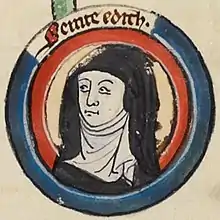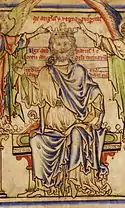Edith of Wilton
Saint Edith of Wilton (c. 963[1] - 16 September 984-987[2] ) (also known as Eadgyth, her name in Old English, or as Editha or Ediva, the Latinised forms of her name) was an English nun, a daughter of Edgar the Peaceful, king of England (r. 959–975). She was born between 961 and 964 and died on 16 September in a year between 984 and 987.[3] Following her death in 984, she became the patron saint of her community at Wilton Abbey in Wiltshire and churches were dedicated to her in Wiltshire and in other parts of Anglo-Saxon England. Her biography was written by Goscelin and her feast day is on 16 September.
Edith of Wilton | |
|---|---|
 | |
| Born | c. 963 Kemsing, Kent |
| Died | c. 986 Wilton Abbey |
| Venerated in | Anglican Communion, Catholic Church, Eastern Orthodox Church |
| Feast | 16 September |
| Attributes | Learning, beauty |
| Patronage | Wilton Abbey |
Life

Edith was the daughter of Edgar, by Wilfrida (or Wulfthryth), a woman of noble birth whom Edgar carried off from the nunnery at Wilton Abbey. He took her to his residence at Kemsing, near Sevenoaks, where Edith was born.[4] Under Dunstan's direction, Edgar did penance for this crime by not wearing his crown for seven years. Although forms of bride-abduction were a traditional part of Anglo-Saxon society, whether Edgar took Wulfryth forcibly is unclear. What we do know is that she stayed with him for at least a year, and that for some time after her return to Wilton, they were on good terms. As soon as Wulfthryth could, she returned to Wilton, taking Edith with her. Edgar continued to support the abbey financially and also with land grants.[5]
Edith was educated by the nuns of Wilton Abbey, where her mother had become abbess. Standing not far from a royal residence at Wilton, as part of its devotional work the Abbey functioned as the contemporary equivalent of a boarding school for young ladies, as did many abbeys at the time.[4] Edgar died in 975, when Edith was about thirteen.
Religious texts, and in particular Edith's biography, written by Goscelin, have probably embellished many details of her life for political and dramatic effect.
She was reported to have always dressed magnificently, the mediaeval chronicler William of Malmesbury stating that she wore luxurious golden garments.[6] When rebuked by Æthelwold of Winchester, she answered that the judgment of God, which alone penetrated through the outward appearance, was alone true and infallible, adding, "For pride may exist under the garb of wretchedness; and a mind may be as pure under these vestments as under your tattered furs".[7] It is known that as abbess St. Wilfrid, Edith's mother, preferred all the nuns at Wilton to dress in white habits with gold ornamentation, to the glory of God. Edgar continued to support Wulfthryth and Edith through the abbey. According to Goscelin, Edgar appointed her abbess of three abbeys, but she was at most thirteen at the time and appointed deputies to act in her place.[8]
Edith built a church at Wilton and dedicated it to Saint Denis. Saint Dunstan was invited to the dedication and is said to have wept during the Mass. When he was asked why he wept, Dunstan said it was because he knew that Edith would die in three weeks. His prediction was proved to be correct when she died on 15 September 984: the story suggests that Edith was suffering from a fatal illness.[4] She was buried at Wilton in the newly dedicated church.[9]
Sainthood
According to her hagiography, Edith was greatly celebrated for her learning, her beauty, and her sanctity.[10] Minor miracles were reported shortly after her death.[4] A week after she died, Edith appeared in glory to her mother and told her that the Devil had tried to accuse her, but that she had broken his head.[11] The early mediaeval writer Goscelin reported that thirteen years after her death Edith appeared in visions to Dunstan and others, to inform them that her body was uncorrupted in the grave. He stated that Dunstan had opened her tomb in the presence of her mother, and that its "fragrant perfumes gave off the breath of paradise". However, the dating of this event must be doubted, as Dunstan himself died only four years after Edith, and it has been suggested that Goscelin may have chosen to enhance Edith's story by associating Dunstan with her translation.[4]
Following her exhumation and subsequent reburial, Edith's thumb was enshrined separately and became an important relic.[9] She was elevated to sainthood at her mother's instigation, and also upon the initiative of her brother Aethelred, and her cause was supported by her nephew, Edmund Ironside. Edmund's successor, Canute, was renowned for his veneration of Edith. Goscelin wrote that while Canute was crossing the North Sea from England to Denmark, his fleet suffered a terrible storm and fearing for his life, he appealed to Edith. The storm calmed and on his return to England, Canute visited Wilton to give thanks for his rescue, "with solemn gifts, and published this great miracle with prolific testimony", subsequently ordering a golden shrine to Edith to be erected at the abbey.[4][12]
Edith became the focus of a major cult in Wilton and an important national saint.[13] Goscelin wrote her Life, under the title Vita Edithe, in about 1080.[14] The community at Wilton, in looking to her as its heavenly patron, remembered her as a royal lady who had been dedicated to its protection.[15] In his Liber Confortatorius, Goscelin wrote that he often thought of Edith and felt her presence.[16]
At least three churches were certainly dedicated to Edith, at Baverstock near Wilton, Bishop Wilton in Yorkshire, and Limpley Stoke in Wiltshire. In the 16th century, after some five hundred years, the third of these churches was rededicated to St Mary, but the other two dedications survive.[4] Another eighteen churches in England are dedicated to an unspecified St Edith, and it has been suggested that most of these dedications are intended for Edith of Wilton.[17] According to The Calendar of the Anglican Church, "There are twenty-one churches dedicated in this name in England, eight of which are in Lincolnshire, and three in Warwickshire. It is now impossible to assign them to their respective saints, especially as two were located in the same county; the one whom William of Malmesbury mentions with most honour was S. Editha of Wilton, whose festival he relates was in his time kept in several parts of the kingdom with great solemnity; probably the majority, if not all, these churches are named in her honour".[10]
Two stories exist related to supernatural events and supposed violations of Edith's remains. In one story, a monk from Ghent tried to cut off a piece of her tunic, and when his knife slipped, it hit her body, which gushed with blood. In another story a nun tried to steal her head-dress, but when she touched it, Edith's head raised itself up.[18]
Wilton Abbey, which was dedicated to St Edith and later to her mother St. Wilfrid as well, is typically described in the later Middle Ages as "the convent of the house and church of St Editha of Wilton" or as the "monastery of St Mary and St Editha of Wilton".[19]
Later abbesses of Wilton told stories relating to private revelations given by St Edith in their times. In one story, in which an abbess's authority was perhaps being doubted, one of the members of the community had a vision in which she saw St Edith appear and put her own veil on the abbess's head, and said that she would bring many goods for the community but would not last long, and these words proved to be true. In another story, dating from the time of Herman, bishop of Sherborne, an abbess complained to the bishop that Edith was not protecting them. After she said this, however, the abbess's cousin had a dream of Edith, in which Edith asked why the abbess had said these things, and Edith had glowing hands and said, "Whatever I want to do with divine aid, I can", and after this was reported to the abbess, she made public repentance of her words.[18]
Edith's feast day is on 16 September, the day of, or the day after the date of her death,[20] although it has also been reported as 15 September.[10] She shares the date with her paternal aunt, At Edith, the abbess of Polesworth.[10]
Seal
Two casts of the seal of Edith have survived, one dating to the fourteenth century and one dating to the sixteenth century.[21] The original seal matrix (now lost) would have dated to the period 975–984. The seal impressions show a portrait of her, standing with one hand raised and the other holding a book. The inscription identifies her as regalis adelpha, or 'royal sister', which is taken to be a reference both to her status as a nun and to her being the sister of Edward and Ethelred. The casts show that the handle of the matrix had a rich acanthus decoration: a gilded bronze seal matrix of an Ælfric found in Hampshire in 2010 and now at the Fitzwilliam museum in Cambridge has a similar handle.[22]
References
- Yorke, Barbara (2008). "The Women in Edgar's Life". In Scragg, Donald (ed.). Edgar, King of the English 959–975. Woodbridge, UK: The Boydell Press. p. 145. ISBN 978-1-84383-928-6.
- https://www.oxforddnb.com/view/10.1093/ref:odnb/9780198614128.001.0001/odnb-9780198614128-e-8482
- Yorke, St Edith
- Kate Pratt, St Edith at bishopwilton.com
- Mrs Jameson, Legends of the monastic orders: as represented in the fine arts p. 95 online at books.google.com
- Catherine E. Karkov, The ruler portraits of Anglo-Saxon England (Woodbridge, Suffolk: Boydell Press, 2004), p. 114
- Jameson, op. cit., p. 96 online at books.google.com
- Hollis, Writing the Wilton Women, p. 47
- Sabine Baring Gould, 'S. Edith of Wilton' in his The Lives of the Saints, vol. X [September] (London: John Hodges, 1875), pp. 269-271
- Church of England, The calendar of the Anglican Church illustrated: with brief accounts of the Saints who have churches dedicated in their names, or whose images are most frequently met with in England (1851) pp. 226-227
- Agnes Dunbar, 'Edith of Wilton', in her A Dictionary of Saintly Women (1904)
- Goscelin, Vita Edithe, quoted in Hollis et al., Writing the Wilton Women (2004), p. 40
- Karkov, op. cit., p. 116
- Susan Janet Ridyard, The Royal Saints of Anglo-Saxon England: a study of West Saxon and East Anglian cults (Cambridge: Cambridge University Press, 1988), p. 40
- Ridyard, op. cit., p. 149
- Jane Tibbetts Schulenburg, Forgetful of their sex: female sanctity and society, c. 500-1100 (Chicago: University of Chicago Press, 1998), p. 340
- 'H. N. R.', in William White, ed., Notes and Queries, vol. 44 (1877) p. 127
- Studies in the Early History of Shaftesbuy Abbey (Dorset County Council, 1999)
- William Campbell, Materials for a history of the reign of Henry VII from original documents (1873), pp. 74, 90
- Francis Goldie, Saints of Wessex and Wiltshire (1885) p. 28
- https://blogs.bl.uk/digitisedmanuscripts/2017/06/making-a-good-impression.html (accessed October 2018)
- https://finds.org.uk/database/artefacts/record/id/542556 (accessed October 2018)
Bibliography
- Hollis, Stephanie; et al., eds. (2004). Writing the Wilton Women: Goscelin's Legend of Edith and Liber Confortatorius. Turnhout, Belgium: Brepols.
- Yorke, Barbara (2004). "Edith [St Edith, Eadgyth] (961x4–984x7)". Oxford Dictionary of National Biography. Oxford University Press. Retrieved 6 May 2018. (subscription or UK public library membership required)
External links
| Wikimedia Commons has media related to Edith of Wilton. |
- Eadgyth 4 at Prosopography of Anglo-Saxon England
- St Edith of Wilton at catholic.org
- St Edith of Wilton at Britannia.com
- At Oxford ODNB